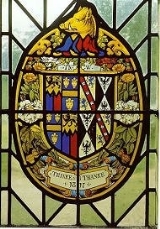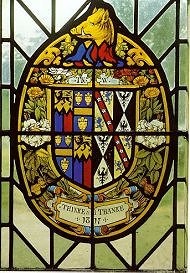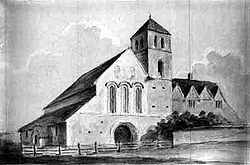
Thomas Willement
Encyclopedia
Thomas Willement, 1786–1871, was a British stained glass
artist, called “the Father of Victorian Stained Glass”, active from 1811 to 1865.

Like many early 19th century provincial stained glass artists, Willement began as a plumber
and glazier
, the two jobs, now separate trades, being at that time linked because both required the skills of working with lead. In 1811, Willement produced a window with a heraldic shield
. It was from this beginning that he went on to become one of the most successful of England’s early 19th century stained glass artists.
under Henry VIII
and the destruction of the Church’s artworks by Puritans in the Parliamentary Period
, there was little stained glass manufacture. Those few windows which were produced between 1500 and 1800 were generally of painted glass in which process the colours were applied by brush to the surface of the glass and fired to anneal them, rather than the artist working with numerous sections of coloured glass and piecing them together.
It has been claimed of Willement that through his observations of old windows, he reinvented the ancient method of leading coloured pieces and integrating the visually black lines created between the colours by the lead cames into the design of the window. From observing 14th century windows such as the West window of York Minster
, Willement developed the artistic method of arranging figures one to each single light, surmounted by a decorative canopy.
He was further encouraged after 1839 in the archaeological direction that his work took by the Cambridge Camden Society
who promoted all things Medievalising in the structure of new churches and the restoration of old ones. Willement was encouraged by the society and also received the patronage of Augustus Welby Northmore Pugin, the most famous ecclesiastical architect and designer of Churches. Unfortunately Willement suffered a falling out with Pugin who accused him of being mercenary. (Pugin also had previously fallen out with his first stained glass artist, Willement’s pupil, William Warrington
.) It is also possible that the style of Willement's figures was not sufficiently archaeologically correct to satisfy Pugin who was himself a meticulous and elegant draftsman.
(reigned 1820–1830) and became, by Royal Patent, “Artist in Stained Glass” to Queen Victoria, making much armorial glass for St George's Chapel, Windsor, and restoring the ancient windows there. In 1851 he was one of the 25 stained glass artists who exhibited at the Crystal Palace
Exhibition.

in Kent, an ancient nunnery established in the 12th century and complete with its own church. (The buildings were spared in the Dissolution of the Monasteries because by 1527 there were only three elderly nuns remaining.) Willement restored and extended the buildings to make a comfortable home, and installed his own heraldic glass with the motto, “Thynke and Thanke”. Since he owned the church as well, he refurbished it with stained glass and had Taylors of Loughborough install five bells, each cast with the same motto, in the bell tower.
Thomas Willement died on 10 March 1871, aged 85 and was buried in a vault in the church which he restored.
Davington Priory has since 1983 been the home of Bob Geldof
KBE.
Stained glass
The term stained glass can refer to coloured glass as a material or to works produced from it. Throughout its thousand-year history, the term has been applied almost exclusively to the windows of churches and other significant buildings...
artist, called “the Father of Victorian Stained Glass”, active from 1811 to 1865.

Biographical
Willement was born on the 18th July 1786 at St Marylebone, London.Like many early 19th century provincial stained glass artists, Willement began as a plumber
Plumbing
Plumbing is the system of pipes and drains installed in a building for the distribution of potable drinking water and the removal of waterborne wastes, and the skilled trade of working with pipes, tubing and plumbing fixtures in such systems. A plumber is someone who installs or repairs piping...
and glazier
Architectural glass
Architectural glass is glass that is used as a building material. It is most typically used as transparent glazing material in the building envelope, including windows in the external walls. Glass is also used for internal partitions and as an architectural feature...
, the two jobs, now separate trades, being at that time linked because both required the skills of working with lead. In 1811, Willement produced a window with a heraldic shield
Heraldry
Heraldry is the profession, study, or art of creating, granting, and blazoning arms and ruling on questions of rank or protocol, as exercised by an officer of arms. Heraldry comes from Anglo-Norman herald, from the Germanic compound harja-waldaz, "army commander"...
. It was from this beginning that he went on to become one of the most successful of England’s early 19th century stained glass artists.
Influences
The great period of stained glass manufacturing had been the period from about 1100 until about 1500. After that time, with the Dissolution of the MonasteriesDissolution of the Monasteries
The Dissolution of the Monasteries, sometimes referred to as the Suppression of the Monasteries, was the set of administrative and legal processes between 1536 and 1541 by which Henry VIII disbanded monasteries, priories, convents and friaries in England, Wales and Ireland; appropriated their...
under Henry VIII
Henry VIII of England
Henry VIII was King of England from 21 April 1509 until his death. He was Lord, and later King, of Ireland, as well as continuing the nominal claim by the English monarchs to the Kingdom of France...
and the destruction of the Church’s artworks by Puritans in the Parliamentary Period
Oliver Cromwell
Oliver Cromwell was an English military and political leader who overthrew the English monarchy and temporarily turned England into a republican Commonwealth, and served as Lord Protector of England, Scotland, and Ireland....
, there was little stained glass manufacture. Those few windows which were produced between 1500 and 1800 were generally of painted glass in which process the colours were applied by brush to the surface of the glass and fired to anneal them, rather than the artist working with numerous sections of coloured glass and piecing them together.
It has been claimed of Willement that through his observations of old windows, he reinvented the ancient method of leading coloured pieces and integrating the visually black lines created between the colours by the lead cames into the design of the window. From observing 14th century windows such as the West window of York Minster
York Minster
York Minster is a Gothic cathedral in York, England and is one of the largest of its kind in Northern Europe alongside Cologne Cathedral. The minster is the seat of the Archbishop of York, the second-highest office of the Church of England, and is the cathedral for the Diocese of York; it is run by...
, Willement developed the artistic method of arranging figures one to each single light, surmounted by a decorative canopy.
He was further encouraged after 1839 in the archaeological direction that his work took by the Cambridge Camden Society
Cambridge Camden Society
The Cambridge Camden Society, later known as the Ecclesiological Society from 1845 when it moved to London, was a learned architectural society founded in 1839 by undergraduates at Cambridge University to promote "the study of Gothic Architecture, and of Ecclesiastical Antiques." Its activities...
who promoted all things Medievalising in the structure of new churches and the restoration of old ones. Willement was encouraged by the society and also received the patronage of Augustus Welby Northmore Pugin, the most famous ecclesiastical architect and designer of Churches. Unfortunately Willement suffered a falling out with Pugin who accused him of being mercenary. (Pugin also had previously fallen out with his first stained glass artist, Willement’s pupil, William Warrington
William Warrington
William Warrington, , was an English maker of stained glass windows. His firm, operating from 1832 to 1875, was one of the earliest of the English Medieval revival and served clients such as Norwich and Peterborough Cathedrals...
.) It is also possible that the style of Willement's figures was not sufficiently archaeologically correct to satisfy Pugin who was himself a meticulous and elegant draftsman.
Success
The break with Pugin did not set back Willement's success. He had been the armorial painter to George IVGeorge IV of the United Kingdom
George IV was the King of the United Kingdom of Great Britain and Ireland and also of Hanover from the death of his father, George III, on 29 January 1820 until his own death ten years later...
(reigned 1820–1830) and became, by Royal Patent, “Artist in Stained Glass” to Queen Victoria, making much armorial glass for St George's Chapel, Windsor, and restoring the ancient windows there. In 1851 he was one of the 25 stained glass artists who exhibited at the Crystal Palace
The Crystal Palace
The Crystal Palace was a cast-iron and glass building originally erected in Hyde Park, London, England, to house the Great Exhibition of 1851. More than 14,000 exhibitors from around the world gathered in the Palace's of exhibition space to display examples of the latest technology developed in...
Exhibition.

Davington Priory
By 1845 Willement, aged 59, had become wealthy and looked around for a home with a suitable resonance in which to spend his later years. He purchased Davington Priory near FavershamFaversham
Faversham is a market town and civil parish in the Swale borough of Kent, England. The parish of Faversham grew up around an ancient sea port on Faversham Creek and was the birthplace of the explosives industry in England.-History:...
in Kent, an ancient nunnery established in the 12th century and complete with its own church. (The buildings were spared in the Dissolution of the Monasteries because by 1527 there were only three elderly nuns remaining.) Willement restored and extended the buildings to make a comfortable home, and installed his own heraldic glass with the motto, “Thynke and Thanke”. Since he owned the church as well, he refurbished it with stained glass and had Taylors of Loughborough install five bells, each cast with the same motto, in the bell tower.
Thomas Willement died on 10 March 1871, aged 85 and was buried in a vault in the church which he restored.
Davington Priory has since 1983 been the home of Bob Geldof
Bob Geldof
Robert Frederick Zenon "Bob" Geldof, KBE is an Irish singer, songwriter, author, occasional actor and political activist. He rose to prominence as the lead singer of the Irish rock band The Boomtown Rats in the late 1970s and early 1980s alongside the punk rock movement. The band had hits with his...
KBE.
Other Early 19th century firms
- William WailesWilliam WailesWilliam Wailes, , was the proprietor of one of England’s largest and most prolific stained glass workshops.- Biographical :Wailes was born and grew up in Newcastle on Tyne, England’s centre of domestic glass and bottle manufacturing. His first business was as a grocer and tea merchant...
- William WarringtonWilliam WarringtonWilliam Warrington, , was an English maker of stained glass windows. His firm, operating from 1832 to 1875, was one of the earliest of the English Medieval revival and served clients such as Norwich and Peterborough Cathedrals...
- Charles Edmund ClutterbuckCharles Edmund ClutterbuckCharles Clutterbuck was a stained glass artist of Stratford, East London. He was originally a painter of miniatures and exhibited eight paintings at the Royal Academy. He began stained glass work in the 1840s. Examples of his work can be seen in many Churches in the South East of England...
- Hardman & Co.Hardman & Co.Hardman & Co., otherwise John Hardman Trading Co., Ltd., founded 1838, began manufacturing stained glass in 1844 and became one of the world's leading manufacturers of stained glass and ecclesiastical fittings...
- Augustus Welby Pugin
Context
- Stained glassStained glassThe term stained glass can refer to coloured glass as a material or to works produced from it. Throughout its thousand-year history, the term has been applied almost exclusively to the windows of churches and other significant buildings...
- Stained glass - British glass, 1811-1918
- Victorian EraVictorian eraThe Victorian era of British history was the period of Queen Victoria's reign from 20 June 1837 until her death on 22 January 1901. It was a long period of peace, prosperity, refined sensibilities and national self-confidence...
- Gothic Revival
- Poor Man's BiblePoor Man's BibleThe term Poor Man's Bible has come into use in modern times to describe works of art within churches and cathedrals which either individually or collectively have been created to illustrate the teachings of the Bible for a largely illiterate population. These artworks may take the form of carvings,...

